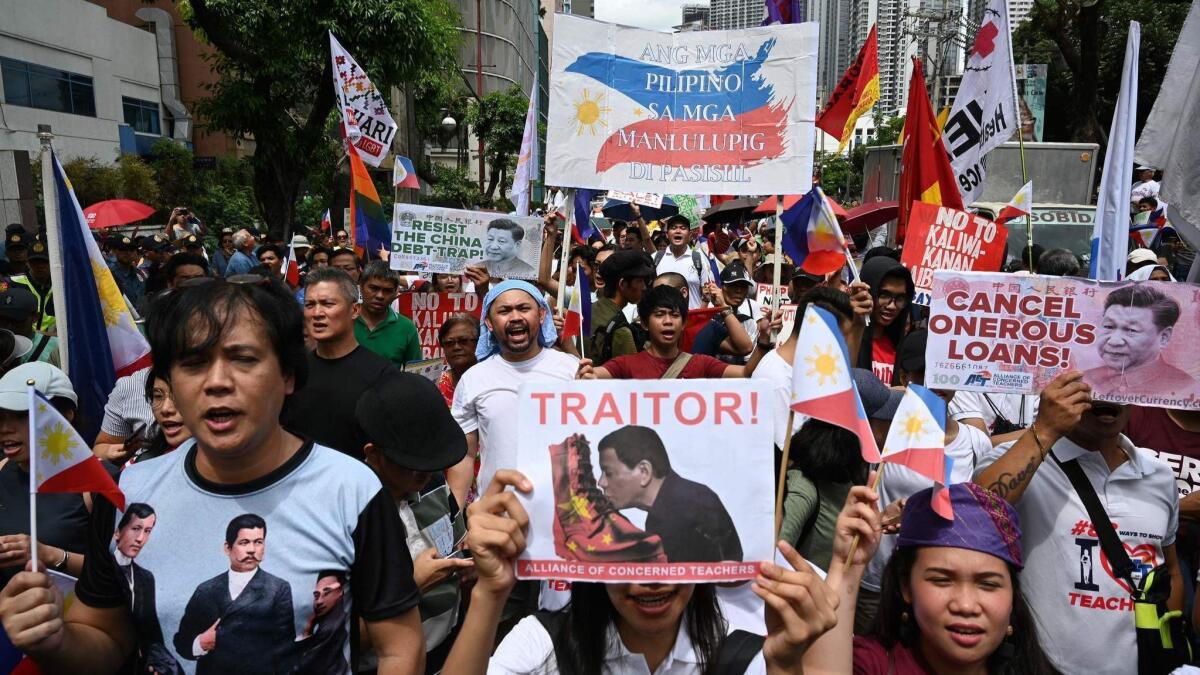Duterte heeds pressure to confront China as midterms approach in the Philippines

Philippine President Rodrigo Duterte’s embrace of China has hit a wall.
A year after joking about his country becoming a province of China and professing his “love” for Chinese President Xi Jinping, Duterte is heeding pressure at home to confront Beijing.
The Philippine strongman known for his bluster employed his toughest language in years against China this month when he told the country to stay away from the Philippine-held island of Thitu or face the prospect of suicide attacks.
Chinese coast guard and fishing vessels have been surrounding the tiny island in the hotly contested South China Sea for months. Known in the Philippines as Pag-Asa, the island houses Philippine troops and includes a runway that could be used to help thwart Beijing’s vast territorial claims to the waters there.
“I will not plead or beg, but I am just telling you [to] lay off the Pag-Asa because I have soldiers there. If you touch that, that’s a different story. I can tell my soldiers, ‘Prepare for suicide missions,’ ” Duterte said in a recent speech.
In response to Duterte, China’s Foreign Ministry said Chinese fishermen had rightful historical claims to the disputed waters.
Duterte’s barbs were backed up by an annual joint military exercise with the U.S. last week that featured the Wasp, an amphibious assault ship equipped with F-35 stealth fighters. It was the biggest show of force between the two sides since Duterte took office in 2016 saying he wanted to part ways with the U.S. and move closer to China.
The friendlier approach with Beijing had been seen by analysts as an effort to help the Philippines win billions of dollars in Chinese loans and reduce tensions in the South China Sea, a vital shipping lane serving one-third of all global maritime traffic.
When Duterte took office, he disparaged President Obama, who had been critical of Duterte’s bloody war on drugs, calling Obama a “son of a whore.” President Trump, on the other hand, has praised Duterte’s approach to crime, giving reason to draw closer to the U.S. again at a time of American-Chinese trade tensions.
Despite the pledges from Beijing, only a handful of loans have materialized and Philippine officials have called them one-sided. At the same time, Philippine fishermen say they continue to be harassed by Chinese coast guards and maritime militia in disputed waters around the Spratly Islands and Scarborough Shoal. The shoal, a triangular chain of reefs and rocks surrounding a lagoon less than 150 miles west of the Philippine island of Luzon, was seized by China in 2012.
The ongoing conflict has further soured the attitude toward China in the Philippines, exacerbated by complaints about Chinese workers being hired for Chinese-funded infrastructure projects and Chinese investors driving up property prices in Manila.
Hundreds of flag-waving citizens marched to the Chinese Embassy in Manila on Tuesday to protest China’s territorial claims at sea, its binding loan agreements for infrastructure projects and the rising presence of Chinese nationals in the Philippines.
“The enemy is no longer outside the gates, they are in our own backyard,” said Jose Antonio Custodio of the Manila-based think tank the Institute for Policy, Strategy and Development Studies.
“The Chinese are seen as displacing Filipinos, taking their jobs and making property too expensive for them to buy,” Custodio added, drawing similarities to anti-immigrant sentiment in other countries. “This is no longer just a territorial issue. We are talking about livelihoods and shelter. It is now an issue of survival.”
As a populist, Duterte is sensitive to the shifting political winds, analysts say, especially with approaching midterm elections next month that will decide 12 of 24 Senate seats and all 297 House seats.
A recent public opinion survey showed that 84% of Filipinos disapproved of the government’s inaction over China’s aggressive incursion into Philippine territory.
That includes Duterte’s decision to downplay a historic 2016 ruling by an international tribunal that favored the Philippines and rejected China’s sweeping claims to the South China Sea.
The softer approach surprised Filipinos considering Duterte had branded himself a defender of Philippine sovereignty during his presidential run. He once pledged to jet ski out to the Spratly Islands or Scarborough Shoal and plant the country’s flag. A spokesman later said it was a joke.
Seeing no effort by the government to challenge China, former officials have begun circumventing the Duterte administration by seeking redress from international bodies.
Albert del Rosario, the Philippines’ former foreign secretary and Conchita Carpio-Morales, a former presidential-appointed ombudsman, filed a complaint before the International Criminal Court in The Hague on March 15 alleging China’s construction of artificial islands for military installations on reefs and atolls around Scarborough Shoal and other islands caused irreversible environmental damage constituting a crime against humanity. (The complaint was filed two days before the Philippines’ withdrawal from the court, which was investigating extrajudicial killings linked to Duterte’s war on drugs).
“All of this is happening because of the foreign policy of the president and his policy is to do nothing. There is a clear disconnect between the problems Filipinos face in the West Philippine Sea and the foreign policy of the president,” said Florin Hilbay, a former solicitor general, using the Philippine name for the South China Sea.
Whether Duterte and his PDP-Laban party will be forgiven for their inaction remains to be seen.
The president’s recent statements on China are clearly a response to mounting public pressure, said Richard Heydarian, a political analyst. But while divisive, the China problem may not be enough for the opposition to win enough House seats to counter Duterte’s consolidation of power, he added.
“The opposition has demonized China too much while underestimating the pragmatic desire of Filipino people to have peaceful relations with Asia’s new superpower,” said Heydarian.
Although local surveys show that China has extremely low trust ratings, Pew surveys indicate that two-thirds of Filipinos prefer a strong economic engagement over confrontation with China.
“This is how Duterte gets away with his China appeasing strategy,” Heydarian said.
That hasn’t stopped the opposition from trying.
This month, senatorial opposition candidates joined fishermen in the coastal town of Masinloc to demand an end to Chinese harassment around Scarborough Shoal.
For generations, fishermen there have claimed rights to the grounds, which are rich with high-value tuna, grouper and Spanish mackerel. But Chinese sailors have blocked their access, boarding their boats, raiding their ice boxes for their best catch and giving them expired cigarettes, noodles or bottled water in exchange. The fishermen say the Chinese sailors have confiscated their cellphones when they attempt to document the incidents.
“The Chinese still do not allow us to enter Scarborough Shoal. We cannot freely fish,” said Wilfredo Labolabo, 32, who has been fishing in the area since he was a child.
“The president is all words, but he isn’t taking action,” Labolabo continued. “We feel discouraged and forsaken.”
The Chinese seized Scarborough Shoal after the Philippine navy apprehended eight Chinese vessels carrying illegally harvested corals and giant clams. The Philippine government filed a case before the Permanent Court of Arbitration in The Hague arguing China’s territorial claims violated international maritime laws.
In July 2016, the international tribunal ruled in favor of the Philippines, but Duterte dismissed the ruling and said that there was no way to enforce it short of going to war with China.
After a state visit to China in October 2016, Duterte returned to the Philippines with more than $24 billion in trade and investment deals and a pronouncement that, through an agreement between him and the Chinese president, Philippine fishermen could go back to Scarborough Shoal. That agreement apparently did not mean access to the lagoon, fishermen report.
“We can fish around Scarborough, but we are not allowed to enter the lagoon for shelter against strong winds,” said Fred Manzano, 67, referring to the coral beds within the lagoon that serve as nesting habitat for fish. “The lagoon is also where the most of the fish are.”
Times staff writer Pierson reported from Singapore and special correspondent Santos from Masinloc.
More to Read
Start your day right
Sign up for Essential California for news, features and recommendations from the L.A. Times and beyond in your inbox six days a week.
You may occasionally receive promotional content from the Los Angeles Times.






